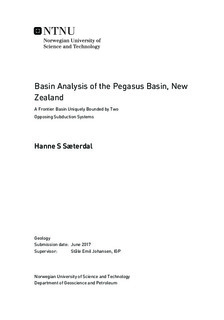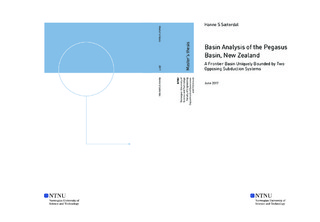| dc.description.abstract | Pegasus Basin is bounded in northwest by the active convergent Australian margin, and in the south by the bathymetric ridge of Chatham Rise, which represents the Mesozoic convergent plate boundary along the Gondwana supercontinent.
The PEG09 survey provide a unique visualization of Pegasus Basin and the two opposing subduction systems within the basin. Based on the high-quality 2D seismic data of the survey, there have been performed a regional seismic study, and a more detailed seismic study of northern slope of the Chatham Rise. The objective of this thesis is obtain a greater understanding of the geological development of Pegasus Basin.
The basin forming mechanisms of Pegasus Basin have changed trough time, with flexural and dynamically induced subsidence being the basin forming mechanisms during Mesozoic and Neogene-Recent times, and thermal subsidence being the basin forming mechanism in Late-Cretaceous and Paleogene. The basin is interpreted to have been initiated at the trench associated with the Mesozoic subduction.
The stratigraphy of Pegasus Basin is relatively simple, consisting of four megasequences, each interpreted to have been deposited during a major tectonic phase. During the subduction along the Gondwana margin in Mesozoic, an buoyant oceanic plateau, the Hikurangi Plateau, was partly subducted to underlay Pegasus Basin, and represents the first megasequence. During the subduction, sediments were scraped off the subducting plate and accreted onto the Gondwana margin, forming an accretionary wedge, which represents the second megasequence.
The convergent setting was followed by a passive margin setting from late Early Cretaceous to Paleogene, and sediments of the third megasequence were deposited during this period of tectonic quiescence. During Neogene, the modern active plate boundary, where the Pacific plate is subducting underneath the Australian plate, propagated to border the Pegasus Basin, resulting in large accumulations of sediments in the Pegasus Basin, which represent the fourth megasequence. The rocks of the fourth megasequence have relatively recently started to be deformed and Incorporated into the active accretionary wedge associated with the modern boundary. The effective plate boundary between the Australian plate and the Pacific plate is set to the top of the second megasequence, and it is suggested that the boundary previously was situated shallower in the stratigraphy, on top of the third megasequence. The sediments of Pegasus Basin is interpreted to mainly have been deposited in a marine depositional environment.
There have been suggested two distinct models of the geological evolution of Pegasus Basin, each encompassing multiple reconstructions showing the systematic development of the basin. The model that is found to represent the most realistic scenario of basin development, is primarily based on the idea of the Mesozoic accretionary wedge forming a natural relief across the southern margin of the basin, and that the passive margin successions were deposited as a drape across the wedge, obtaining the northwest dip that the strata exhibit today.
There are observed dissimilarities between our study of the Pegasus Basin and previous studies. Key dissimilarities includes the regional interpretation of the stratigraphy of the basin, the location of the effective plate boundary between the Australian plate and the Pacific plate, and the site of basin initiation.
There have been performed a preliminary qualitative evaluation of the prospectivity of Pegasus Basin. It is suggested that the critical moment when all the elements of the petroleum system coincided, occurred 8 Ma. Critical factors for the prospectivity includes migration, trapping and reservoir distribution and quality. Based on this preliminary evaluation, the prospectivity of the Pegasus Basin is interpreted to be poor. | |

